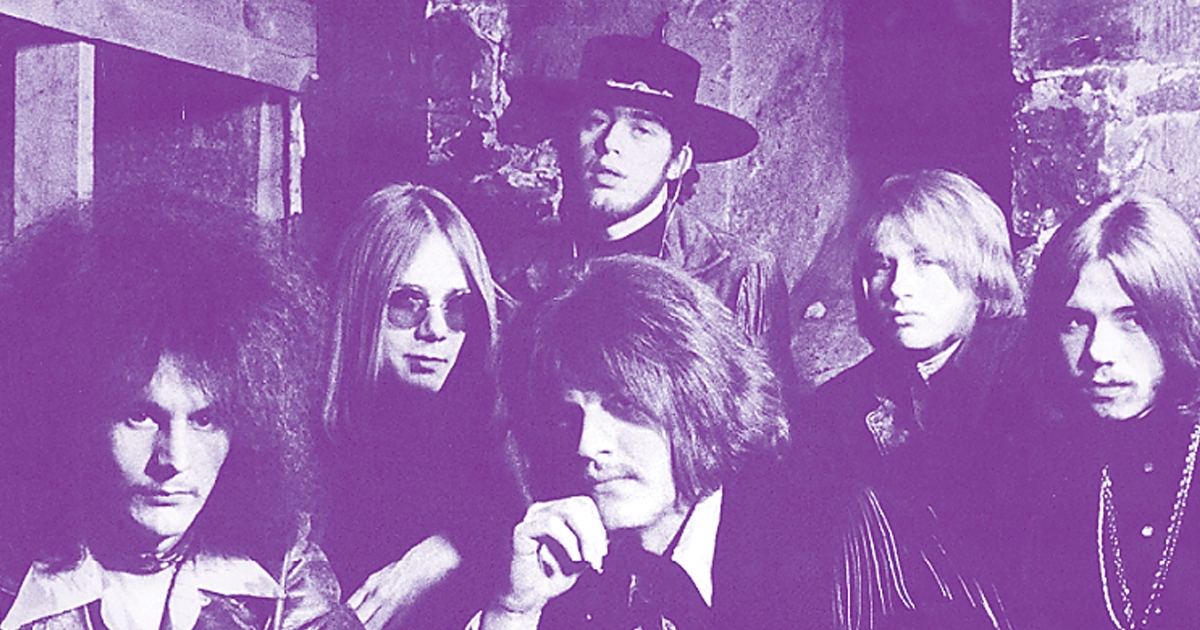In the case of Billings psych-rock band The Frantics, it has taken 50 years for their 1968 album Birth to see the light of day. Recorded a half-century ago in Norman Petty’s studios in Clovis, New Mexico (where Buddy Holly recorded), Birth never made it to record stores until April 2018.
One European music critic, Alex Carretero, called Birth “Probably the greatest lost US psych album ever.”
Thanks to Dave Martens, who put the record out this year on Lost Sounds Montana, a reissue label based in Havre dedicated to the preservation of historic Montana recordings, the world finally has a chance to hear this astonishing and accomplished piece of Rock-n-Roll history.
The Frantics narrowly missed becoming a band as big as those they toured with, including The Yardbirds, The Young Rascals, and the Everly Brothers. The full list of their connections to the world’s great rock-n-roll acts reads like a Rolling Stone Magazine schematic chart of 1960s band history.
The Frantics got their start in Billings. Mont., in the spring of 1964 at Eastern Montana College. The original members were Don Mock, Larry Krank, Vaughn Smith, and Max Byfuglin. In 1965, Don Kingery joined the band, taking over drumming duties so that Max Byfuglin could focus on being the lead singer.
Later that year, Bill Kogolshak replaced Krank on bass, and Kim Sherman replaced Vaughan Smith on lead guitar. Sherman was a welcome addition, having achieved some notoriety in another local band called The Malibus, who enjoyed a regional hit with a song called “Mr. Malibu.”
In early 1966, the Frantics recorded a 45 at Klier Sound Studio in Billings, “Route 66” with “La Do Da Da” on the B-side.
They acquired a manager, Ray Ruff, who booked the band in venues well outside their home state.
Over the next year, as the band made a name for themselves in California, Arizona, New Mexico, and Colorado, they went through several lineup changes, eventually becoming a six-piece “psychedelic” rock band. By the time they began recording Birth in 1968, the “classic” lineup of The Frantics featured Phil “Gordo” Head on drums, Max Byfuglin on vocals, Jim Haas on keyboard, vocals, trumpet, Kim Sherman on lead guitar, David Day on bass, and Dennis Devlin on rhythm guitar.
Between 1964 and 1967, The Frantics quickly rose to prominence as one of the most sought-after and promising bands in Montana. In 1967, along with a band called Initial Shock, they started touring nationally, sharing the stage with such acts as The Who, Jethro Tull, Love, The Yardbirds, and Alice Cooper, to name a few.
Some of the highlights of those years recounted by the surviving members of the band involved a late-night jam session with Jimi Hendrix and Jim Morrison of The Doors, as well as crossing paths with the Beatles in a New York club.
In recalling those years recently, bass player David Day remarked, “there was not a lot of hard rock bands in Montana, and The Frantics just had this mystique, this kind of charisma. After the tour in 1966, we had a San Francisco-style light show, and a more psychedelic sound. I’d say we sounded like Pink Floyd meets Led Zeppelin.”
In 1968, Phil Head recommended the famous Norman Petty Studio in Clovis, N.M., as the place to cut their debut album, a landmark studio where not only Buddy Holly started his career, but Waylon Jennings and Roy Orbison as well. Petty rivaled Phil Spector as one of the great rock-n-roll producers, though psychedelic rock was a bit out of his wheelhouse.
The band recorded a dozen tracks with Petty, but the contract they’d signed limited their access to the tapes unless a record label agreed to use them.
When The Frantics did make a record deal a year later, the producers decided to have the band start over in a new studio, which meant that if the band wanted the Petty material, they’d have to foot the bill themselves. As a consequence, the original recordings for Birth would sit in the archive in Clovis for 50 years.
In 1969, the band recorded a second record called Conception, which received some critical acclaim, but the record lacked the verve and originality of their earlier recordings. As Martens pointed out, the second album only featured a few originals, and only two of the songs from the Norman Petty sessions made it on Conception.
A year later, as the band’s shot at a major release failed to gain traction, the band decided to call it quits.
But the members of The Frantics all went on to have tremendous success in other bands. David Day for example, formed a band in LA in 1972 called Whitehorse, whose lineup included a lead guitarist named Mick Mars, who would a few years later achieve great fame playing guitar for the heavy metal band Mötley Crüe. When Mars joined the Crüe, he took a few of Whitehorse’s tricks with him, including the gimmick of having the drummer on stage play upside-down in a special kit.
Jim Haas, meanwhile, went on to do studio session work for years, achieving his greatest notoriety as the fellow who sang the popular TV show Happy Days theme song. He also performed background vocals on the studio albums of dozens of acts, most famously for Pink Floyd’s album The Wall in 1979.
In 1980-81, Haas toured with Pink Floyd as a backup singer and reprised his role when Roger Waters resurrected the famous The Wall show in 1990 in Berlin after the Berlin Wall came down.
Sadly, Jim Haas died in April of 2018, a day before Birth finally made it to vinyl, 50 years after he had first sung on the original tracks.
They may not have realized it at the time, but the members of the Frantics were making Rock & Roll history as one of the few 1960s bands from Montana to brush up against the big time. The members have proud memories of their days in Santa Fe and L.A.
“At the time I joined the band, I only knew that they were from Montana,” recalled Phil Head. “I had seen them perform in Pueblo, Colo., at the Fantastic Zoo and thought they were the best band I had ever seen. This was the first time I’d seen what I consider a power band. Their energy and charisma were overwhelming.”
Head also notes the band had an unparalleled work ethic. “We always made the gig,” recalls Phil Head in the liner notes to Birth. We broke down in one of the worst blizzards New Mexico had in a hundred years, [and] we broke down in the Mojave Desert. We broke down in Castle Rock, Colorado, in a snowstorm, and Larry hiked a good mile to the only gas station to get the parts we needed. We drove across South Dakota with a cracked wheel on the truck wobbling, but we made the gig. We always made the gig. We were opening for Jethro Tull and Richie Havens at the Aragon Ballroom, and hours before we were to go on, a drunk cop broke David’s finger and then arrested him…but we made the gig.”
And not only did they always make the gig, but they put on great shows.
“The thing about a Frantics show,” David Day said, “is that people would be stunned. They would walk out afterward just stunned. It was that good.”
Thanks to Dave Martens and his love of “lost” Montana music, the Frantics’ Birth has finally hit the music store shelves, much to the delight of local audiophiles. It’s a monument to the 1960s era and its affection for psychedelic sound and songwriting. It’s clearly an important artifact in the annals of Montana music history.
The musicianship and sonic quality of the album is impressive — this is not some garage band who happened to cut a record on the cheap back in the day.
Kim Sherman’s lead guitar work is crisp and precise, and surprisingly melodic for the late 60s. Byfuglin and Haas generate some powerful vocal work as well. The overall effect is interesting, because the album sounds both fresh and contemporary in the psych genre, but it also feels a bit like a sonic time capsule.
“It’s surprising how well that thing holds up 50 years later,” David Day noted recently.
Martens started the Lost Sounds Montana record label in Missoula in 2011 along with some other DJs at the college radio station, KBGA. Martens later launched a popular website (lostsoundsmontana.bandcamp.com/music) where he archives hundreds of recordings of Montana musicians ranging from old school country like Boone and the Buckskins to The Frantics.
According to Martens, the mission of Lost Sounds Montana is “to preserve, archive, showcase, and make accessible the music and associated history of Montana across the decades.”
Bringing Birth to the world was a complicated and challenging effort, according to Martens. “The Norman Petty Estate, which manages the tape archive, very rarely allows recordings to be prepared for release,” he said.
“Recently, through the work of people like Shawn Nagy, efforts have begun to restore, preserve, and release the entire archive. The Norman Petty Estate even resurrected the Nor-Va-Jak label, originally Petty’s in-house label, to fund this [The Frantics’ Birth] and future archival releases.” MSN










